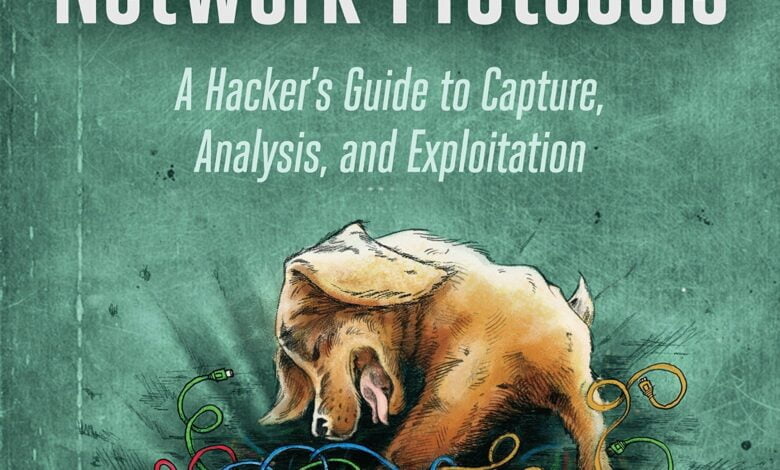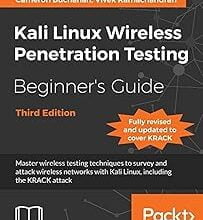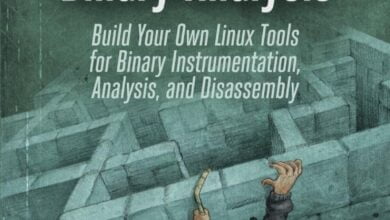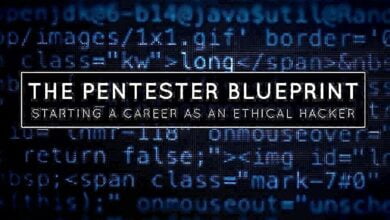Attacking Network Protocols: A Hacker's Guide to Capture, Analysis, and Exploitation
by James Forshaw

Rating: 4.6/5
Welcome, fellow cybernauts! Today, we dive deep into the digital pulse of our interconnected reality with James Forshaw’s critically acclaimed Attacking Network Protocols: A Hacker’s Guide to Capture, Analysis, and Exploitation. With an impressive rating of 4.6/5, there’s more to this book than meets the eye. So, let’s tunnel through the layers, unearthing the treasures and pitfalls of this modern-day magnum opus.
Decoding the Matrix with Forshaw
One of the striking features of Forshaw’s work is his ability to tread the fine line between depth and accessibility. In a landscape replete with generic guides and superficial how-tos, this tome emerges as a breath of fresh air. It introduces the uninitiated to the world of network protocol analysis, making the complex dance of packets and data frames accessible and intuitive. Forshaw’s expert guidance in setting up Wireshark – the holy grail of network protocol analyzers – is a testament to his deep understanding and passion for the subject. As he poignantly observes, “Wireshark is to network analysis as a scalpel is to a surgeon.”
Beyond the Known Horizons: What truly distinguishes this piece is its fearless foray into the less-charted territories of the digital universe. Instead of treading the beaten path of TCP/IP and HTTP protocols, Forshaw enlightens his readers about the enigmatic SMB and RPC protocols. His analogical brilliance shines through when he equates RPC communications with a postal system for the digital world, demystifying what is often considered arcane.
Moreover, the essence of this book lies in its focus on exploitation. To truly master the digital landscape, one must not only understand its topography but also the art of navigating its vulnerabilities. Forshaw’s practical guide on manipulating HTTP requests to exploit web applications is a masterclass in turning theoretical knowledge into actionable insights.
Cautions for the Digital Voyager: While Forshaw’s tome is a repository of knowledge, it demands dedication and patience. Novices might find themselves occasionally swimming against the current, given the dense technical content. The book, while rich in hands-on techniques, does assume a certain level of foundational knowledge. The challenges can be likened to traversing a dense forest where the path isn’t always clear, but the journey is undeniably enriching.
Understanding the Learning Curve in Attacking Network Protocols
Diving into James Forshaw’s guide, one quickly realizes that the text caters to a diverse spectrum of readers, each at varying stages in their journey through the world of network protocols. This differentiation is crucial, as it ensures that everyone, from the novice to the maestro, finds a foothold in this intricate dance of bytes and packets.
For the absolute novices or those embarking on their maiden voyage into this digital sea, the experience of reading “Attacking Network Protocols” can be likened to their first attempt at scaling a mountain like Everest. There might be moments of trepidation, of feeling overwhelmed by the technical jargon and intricate diagrams. The ascent appears steep, the air thin, and the path arduous. However, with dedication, resilience, and the guidance that Forshaw offers, the view from the peak is within reach. Each chapter unraveled, every concept grasped, rewards the reader with an unparalleled vista of the digital landscape.
As we move on to the intermediate enthusiasts, or what we might term the ‘ascenders,’ they will find a wealth of resources in the book that caters to their burgeoning curiosity. These are individuals who’ve had a taste of the digital realm, perhaps have dabbled in some basic coding, or have a fundamental grasp of networks. For them, Forshaw’s real-world examples aren’t just theoretical constructs but tangible challenges. They serve as both lessons and sandboxes, spaces where acquired knowledge can be applied, tested, and refined.
For those seasoned in the realm of network protocols, the experienced lot who have already ventured deep into the digital forests, this book provides uncharted territories to explore. These are the individuals who’ve encountered protocols like TCP/IP and HTTP in their endeavors. However, with Forshaw’s guidance, they can now delve into the mysteries of lesser-known protocols like SMB and RPC. The book aids them in unearthing these hidden gems, adding to their repertoire and enhancing their expertise.
The elites of the cyber world, those who have not just explored but also mastered vast stretches of the digital landscape, will find “Attacking Network Protocols” a veritable playground. These are the mavens for whom the book’s practical exploits are more than just lessons; they are opportunities. Each exploit offers them a chance to refine their techniques, challenge their skills, and showcase their prowess. Forshaw’s intricate walkthroughs serve as both inspiration and instruction, enabling these elites to further sharpen their digital blades.
Lastly, there are the maestros, the virtuosos of the digital symphony, who might wonder what more they can glean from such a guide. For them, Forshaw’s work emerges as a comprehensive lexicon, offering nuanced insights and innovative techniques that they might have overlooked. While they might be well-versed in the art of attacking network protocols, Forshaw’s fresh perspectives, detailed analysis, and forward-thinking approach ensure that even they discover uncharted territories, new attack vectors, and more refined methodologies.
In essence, “Attacking Network Protocols” is a journey, one that is as varied and rich as the travelers undertaking it. Whether you’re setting foot on this path or have already traversed its many bends, Forshaw ensures there’s always something valuable waiting to be discovered.
A Boon for Bug Bounty Hunters: In our rapidly digitizing world, with cybersecurity becoming paramount, there’s an unprecedented demand for those who can identify, understand, and rectify the inherent flaws in our systems. This is where Forshaw’s guide comes in handy.
Protocol-level vulnerabilities often remain concealed, but when uncovered, they yield significant rewards. These deep-rooted flaws are what this book helps illuminate, offering a potential goldmine for bounty hunters. Furthermore, every practical exploit detailed by Forshaw can be viewed as an invaluable addition to a professional portfolio, paving the way for greater recognition and lucrative opportunities.
The Future and Beyond: Navigating the Evolution of Network Protocols
In our rapidly evolving digital age, the importance of understanding and anticipating the trajectory of network protocols cannot be understated. James Forshaw’s Attacking Network Protocols provides a compelling snapshot of the current landscape, but it also encourages readers to look beyond the horizon and ponder the ramifications of a world more interconnected than ever before.
One can’t help but be intrigued by the implications of emerging technologies in the realm of network protocols. The rise of IoT (Internet of Things) devices, for instance, is revolutionizing the way our appliances, vehicles, and even cities communicate. Each device that joins this vast digital conversation speaks a language governed by protocols, and with this proliferation, there’s an amplification of potential entry points for exploitation. Imagine a future where your refrigerator, car, and even your coffee maker aren’t just benign devices but potential gateways for cyber-attacks.
Similarly, the heralding of 5G technology isn’t just about faster download speeds or more efficient communication. It’s about a paradigm shift in data exchange and network management. As this technology gains traction, the very foundations of data exchange will undergo a transformation. This begs the question: Are our current protocols equipped to handle this metamorphosis? What new vulnerabilities might surface, and how do we preemptively address them?
Moreover, with the increasing integration of AI (Artificial Intelligence) and ML (Machine Learning) into our digital infrastructure, the dynamics of network communication are bound to evolve. Machines aren’t just passive participants in this digital ballet anymore; they’re active choreographers, learning, adapting, and occasionally making mistakes. Forshaw’s book underscores the importance of understanding the underpinnings of these protocols. Still, one must also ponder how these protocols will evolve when machines play a more significant role in crafting and managing them.
It’s also worth noting that as our digital lives become increasingly intertwined with augmented reality (AR) and virtual reality (VR), the need for secure and efficient protocols will escalate. These aren’t mere tools for entertainment but are poised to redefine industries from healthcare and education to real estate and tourism. Each virtual interaction, each augmented overlay, hinges on robust network protocols to function seamlessly. This again brings to the forefront the importance of not just understanding but also fortifying these protocols against potential exploits.
In essence, “Attacking Network Protocols” isn’t just a guidebook for the present but a philosophical treatise for the future. It compels readers to appreciate the intricate dance of data packets and frames today but also to prepare for a tomorrow where the stage is larger, the dancers more numerous, and the choreography infinitely more complex. Forshaw’s work serves as a timely reminder that as gatekeepers of this digital frontier, our vigilance, curiosity, and adaptability will shape the safety and innovation of our interconnected futures.
Reflections on Forshaw’s Digital Odyssey
Every so often, a book emerges that not only educates its readers but also challenges their perceptions, reshaping the contours of an entire field. James Forshaw’s Attacking Network Protocols is such a transformative work, pushing boundaries and providing fresh perspectives in the ever-evolving world of cybersecurity. In retrospect, its influence and significance become even more pronounced.
When considering the vast landscape of digital literature available, Forshaw’s text distinguishes itself by not just explaining the intricacies of network protocols but also by inviting readers on a journey of exploration, discovery, and even enlightenment. It’s not merely a compendium of information; it’s a narrative that weaves complex ideas into a tapestry of real-world scenarios, hands-on experiences, and actionable insights.
In retracing our steps through the book’s chapters, one can’t help but be struck by the sheer depth and breadth of Forshaw’s expertise. His approach to often arcane topics isn’t pedantic or overly technical; rather, it’s engaging, almost conversational. He demystifies jargon, makes abstract concepts tangible, and paints vivid pictures that linger in the reader’s mind. Phrases like “Wireshark is to network analysis as a scalpel is to a surgeon” aren’t just clever soundbites; they encapsulate complex ideas with clarity and precision, acting as guiding beacons for the reader.
Furthermore, in retrospect, Forshaw’s foresight becomes evident. When he delves into lesser-known protocols or ventures into the darker recesses of the digital realm, he’s not just showcasing his knowledge; he’s anticipating the challenges and vulnerabilities of tomorrow. His emphasis on exploitation, both in understanding and addressing it, underscores a deeper truth about the digital age: To safeguard our future, we must intimately understand our present, warts and all.
One might also reflect upon the book’s balance of theory and practice. Forshaw doesn’t just theorize or pontificate; he rolls up his sleeves and dives deep, showcasing the nitty-gritty of network protocol analysis and exploitation. This balance is crucial, for it ensures that readers aren’t just passive consumers of information but active participants in their own learning journey.
Another element that becomes evident in hindsight is the universality of Forshaw’s message. While his primary audience may be cybersecurity enthusiasts, bug bounty hunters, and network analysts, the principles he expounds resonate with anyone who interacts with the digital world. In an era where data breaches make headlines and personal information becomes a valuable commodity, understanding the vulnerabilities and safeguards of our digital infrastructure isn’t just for the experts; it’s a societal imperative.
Closing the final pages of Attacking Network Protocols, one realizes that it’s more than a book. It’s an experience, a testament to Forshaw’s passion, and a clarion call for a more secure, informed, and resilient digital future. Looking back, readers can only be grateful for having embarked on this odyssey and eager to apply its lessons in the days, months, and years to come.




